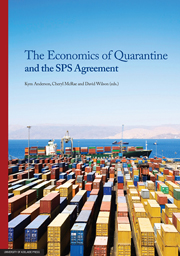Book contents
- Frontmatter
- Contents
- List of tables, figures and boxes
- Acronyms
- Preface
- List of contributors
- 1 Introduction
- PART I The multilateral rules under WTO
- PART II The ‘appropriate level of protection’
- 6 Appropriate level of protection: a European perspective
- 7 Appropriate level of protection: an Australian perspective
- 8 Appropriate level of protection: a New Zealand perspective
- 9 Beyond iso-risk to include benefits under the SPS Agreement
- 10 Integrating import risk and trade benefit analysis
- PART III Adding more economics to risk analysis
- PART IV Specific health and environmental risks from trade
- PART V Conclusion
- APPENDIX The legal text of the SPS Agreement
8 - Appropriate level of protection: a New Zealand perspective
from PART II - The ‘appropriate level of protection’
Published online by Cambridge University Press: 05 June 2013
- Frontmatter
- Contents
- List of tables, figures and boxes
- Acronyms
- Preface
- List of contributors
- 1 Introduction
- PART I The multilateral rules under WTO
- PART II The ‘appropriate level of protection’
- 6 Appropriate level of protection: a European perspective
- 7 Appropriate level of protection: an Australian perspective
- 8 Appropriate level of protection: a New Zealand perspective
- 9 Beyond iso-risk to include benefits under the SPS Agreement
- 10 Integrating import risk and trade benefit analysis
- PART III Adding more economics to risk analysis
- PART IV Specific health and environmental risks from trade
- PART V Conclusion
- APPENDIX The legal text of the SPS Agreement
Summary
One of the outcomes of the Uruguay Round of the General Agreement on Tariffs and Trade (GATT) was the provision for reductions in a range of agricultural trade barriers. In particular, certain types of barriers, such as tariffs, export subsidies, embargoes, import bans, quotas, supply management regimes, domestic price supports, licensing and exchange controls, were able to be dealt with by converting them into ‘tariff-equivalent’ levels of protection through a system of ‘tariffication’. The key success of this approach was that different ‘quantifiable’ trade barriers could then be compared, reduced or negotiated in a common framework of tariffs. What remained to be resolved after the Uruguay Round were a range of trade barriers that were largely non-quantifiable in terms of tariff-equivalent levels of protection. These barriers, termed ‘Technical Barriers to Trade’ (TBT), included rules and standards directed at health, safety or the environment.
A key feature of TBT's, which differentiates them from quantifiable trade barriers, is that they are not specifically targeted at trade or production issues. Under GATT rules, countries are “generally allowed” to adopt health, safety or environmental policies which take precedence over other rules. The caveat to this, however, is that these policies are only allowed as long as the purpose of the policy or standard is to meet a legitimate domestic objective, and as long as domestic and foreign producers are treated in the same manner.
- Type
- Chapter
- Information
- The Economics of Quarantine and the SPS Agreement , pp. 141 - 163Publisher: The University of Adelaide PressPrint publication year: 2012



